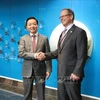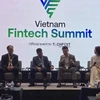Despite making heavy investments in developing 4G services in the world market, mobile network operators are still concentrating on 3G development plans in Vietnam, the English language news website VietNamNet Bridge reported on May 7.
Qualcomm’s Regional Director, Thieu Phuong Nam, in charge of the Lao, Vietnamese and Cambodian markets, noted that there are still great opportunities for 3G development in Vietnam, therefore, no need to be in too much of a hurry to shift to 4G.
“The biggest goal now for Qualcomm in Vietnam is developing the number of 3G service users,” Nam was quoted as saying.
The number of 3G users in Vietnam remains modest, which is far below the average proportion of 70-80 percent in developed countries. This means that the market is still far from the saturation point, and that there is still “wild land” for enterprises to cultivate.
Ericsson Vietnam’s CEO, Jan Wassenius, also thinks that Vietnam still has not used up the 3G’s “power”. The current 3G network is many times more capable of satisfying the real demand.
The senior executive thinks that if the data output to be transferred through the 3G network increases by two fold every year, Vietnam should start 4G in 2015.
While Qualcomm and Ericsson think that the 3G market is “ripe”, and the 4G market still “green”, Huawei’s newly appointed CEO Yuan Song remains skeptical when asked about the time to begin utilizing 4G. He said market demand will decide when to launch 4G services.
Vietnam is known as the country where the 3G service fee is the lowest in the world, while the service quality has been improving well. Mobile network operators are making hectic preparations for launching the 3.5G service nationwide.
Minister of Information and Communication Nguyen Bac Son, at the working session with Samsung recently, said Vietnam has been providing 3G services since 2009, and has 20 million subscribers so far.
According to Son, Vietnam is implementing the national TV digitalisation programme, while planning to use the waveband to be redundant for 4G network. The ministry is now thinking carefully about when Vietnam should start 4G.
It took Vietnam 10 years to switch from 2G to 3G, but it is expected to take less time to make the jump from 3G to 4G.
Son said a reasonable transition time could be 2015. However, he has advised businesses to prepare for 4G right now.
Also according to Hoan, with the increasingly high market demand, the demand for the broadband frequency in Vietnam would be very large. MIC has decided to reserve the 2.3GHz and 2.6GHz frequency bands for wireless broadband. The allocation of the wavebands will be granted through bidding after 2015.-VNA
Qualcomm’s Regional Director, Thieu Phuong Nam, in charge of the Lao, Vietnamese and Cambodian markets, noted that there are still great opportunities for 3G development in Vietnam, therefore, no need to be in too much of a hurry to shift to 4G.
“The biggest goal now for Qualcomm in Vietnam is developing the number of 3G service users,” Nam was quoted as saying.
The number of 3G users in Vietnam remains modest, which is far below the average proportion of 70-80 percent in developed countries. This means that the market is still far from the saturation point, and that there is still “wild land” for enterprises to cultivate.
Ericsson Vietnam’s CEO, Jan Wassenius, also thinks that Vietnam still has not used up the 3G’s “power”. The current 3G network is many times more capable of satisfying the real demand.
The senior executive thinks that if the data output to be transferred through the 3G network increases by two fold every year, Vietnam should start 4G in 2015.
While Qualcomm and Ericsson think that the 3G market is “ripe”, and the 4G market still “green”, Huawei’s newly appointed CEO Yuan Song remains skeptical when asked about the time to begin utilizing 4G. He said market demand will decide when to launch 4G services.
Vietnam is known as the country where the 3G service fee is the lowest in the world, while the service quality has been improving well. Mobile network operators are making hectic preparations for launching the 3.5G service nationwide.
Minister of Information and Communication Nguyen Bac Son, at the working session with Samsung recently, said Vietnam has been providing 3G services since 2009, and has 20 million subscribers so far.
According to Son, Vietnam is implementing the national TV digitalisation programme, while planning to use the waveband to be redundant for 4G network. The ministry is now thinking carefully about when Vietnam should start 4G.
It took Vietnam 10 years to switch from 2G to 3G, but it is expected to take less time to make the jump from 3G to 4G.
Son said a reasonable transition time could be 2015. However, he has advised businesses to prepare for 4G right now.
Also according to Hoan, with the increasingly high market demand, the demand for the broadband frequency in Vietnam would be very large. MIC has decided to reserve the 2.3GHz and 2.6GHz frequency bands for wireless broadband. The allocation of the wavebands will be granted through bidding after 2015.-VNA



















